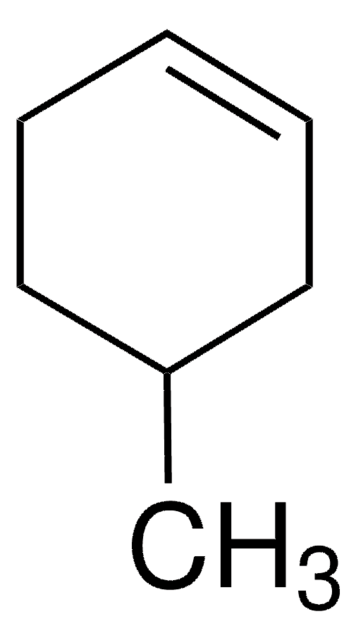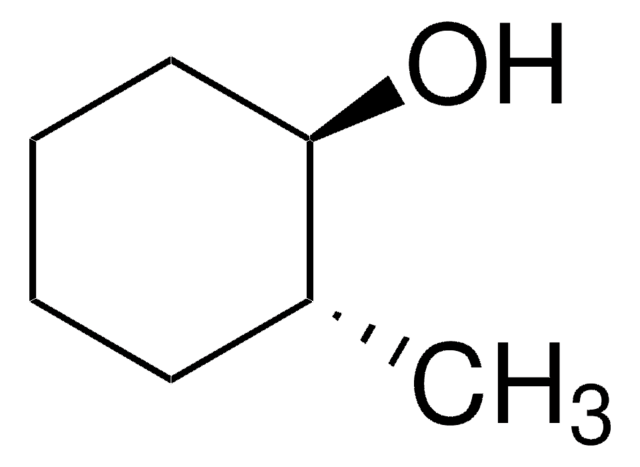All Photos(1)
About This Item
Linear Formula:
CH3C6H10OH
CAS Number:
Molecular Weight:
114.19
EC Number:
MDL number:
UNSPSC Code:
12352100
PubChem Substance ID:
NACRES:
NA.22
Recommended Products
Quality Level
Assay
97%
refractive index
n20/D 1.455 (lit.)
bp
173-175 °C (lit.)
density
0.912 g/mL at 25 °C (lit.)
functional group
hydroxyl
SMILES string
C[C@@H]1CC[C@@H](O)CC1
InChI
1S/C7H14O/c1-6-2-4-7(8)5-3-6/h6-8H,2-5H2,1H3/t6-,7-
InChI key
MQWCXKGKQLNYQG-LJGSYFOKSA-N
Related Categories
General description
trans-4-Methylcyclohexanol is an active Aedes triseriatus oviposition attractant.
Application
trans-4-Methylcyclohexanol was used to prepare 4-methylcyclohexyl nitrite to study the laser-induced fluorescence (LIF) excitation spectra of the 4-methylcyclohexoxy and d11-cyclohexoxy radicals.
Biochem/physiol Actions
trans-4-Methylcyclohexanol is the major metabolite formed by biological regioselective reduction of 4-methylcyclohexanone by Glomerella cingulata.
Signal Word
Warning
Hazard Statements
Precautionary Statements
Hazard Classifications
Acute Tox. 4 Dermal - Acute Tox. 4 Inhalation - Acute Tox. 4 Oral - Eye Irrit. 2 - Skin Irrit. 2 - STOT SE 3
Target Organs
Respiratory system
Storage Class Code
10 - Combustible liquids
WGK
WGK 3
Flash Point(F)
158.0 °F - closed cup
Flash Point(C)
70 °C - closed cup
Personal Protective Equipment
dust mask type N95 (US), Eyeshields, Gloves
Choose from one of the most recent versions:
Already Own This Product?
Find documentation for the products that you have recently purchased in the Document Library.
Customers Also Viewed
Lei Zhang et al.
The journal of physical chemistry. A, 109(41), 9232-9240 (2006-07-13)
The laser-induced fluorescence (LIF) excitation spectra of the 4-methylcyclohexoxy and d11-cyclohexoxy radicals have been measured for the first time. LIF intensity was used as a probe in direct kinetic studies of the reaction of O(2) with trans-4-methylcyclohexoxy and d11-cyclohexoxy radicals
Biological enantioselective reduction of methylcyclohexanones by Glomerella cingulata.
Miyazawa M, et al.
Journal of Chemical Technology and Biotechnology, 65(2), 171-175 (1996)
Jianzeng Guo et al.
Science (New York, N.Y.), 309(5732), 307-310 (2005-07-09)
Different modalities of sensation interact in a synergistic or antagonistic manner during sensory perception, but whether there is also interaction during memory acquisition is largely unknown. In Drosophila reinforcement learning, we found that conditioning with concurrent visual and olfactory cues
Studies of 4-methylcyclohexanol: an Aedes triseriatus (Diptera: Culicidae) oviposition attractant.
M D Bentley et al.
Journal of medical entomology, 19(5), 589-592 (1982-10-14)
J R Linley
Medical and veterinary entomology, 3(4), 347-352 (1989-10-01)
Laboratory experiments tested the effects of p-cresol or 4-methylcyclohexanol at concentrations of 1, 10 and 50 ppm, on oviposition by the mosquitoes Toxorhynchites brevipalpis Theobald, Tx. amboinensis (Doleschall) and Tx. splendens (Wiedemann). A 5 + 5 ppm mixture of the
Our team of scientists has experience in all areas of research including Life Science, Material Science, Chemical Synthesis, Chromatography, Analytical and many others.
Contact Technical Service








